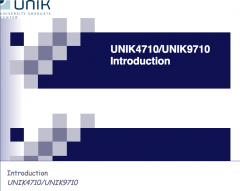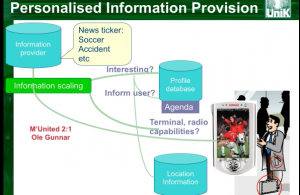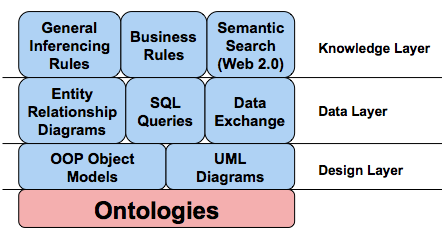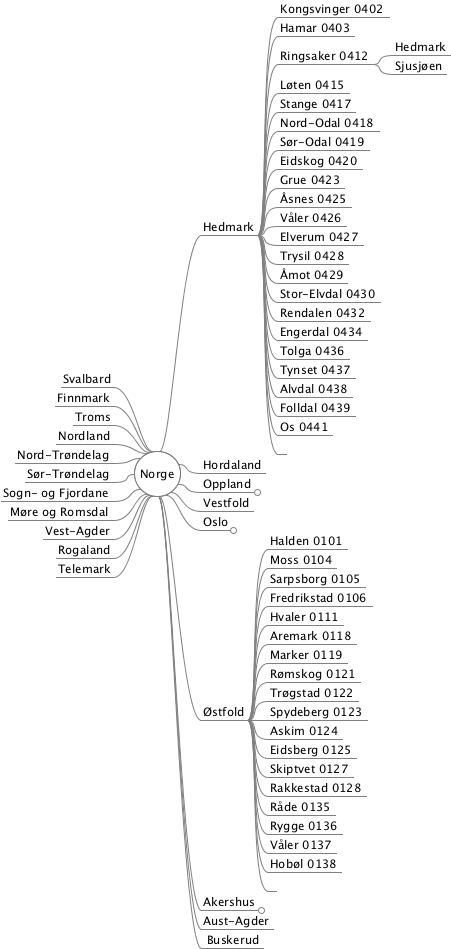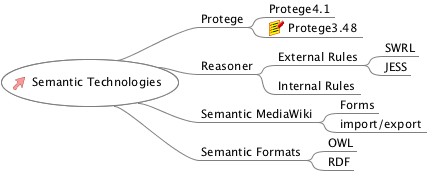Basics of Semantics
From its-wiki.no
| Wiki for ITS | ||||||
|---|---|---|---|---|---|---|
|
Basics of Semantics
| Course | UNIK4710, UNIK9710 |
|---|---|
| Title | Basics of Semantics |
| Lecture date | 2015/02/06 |
| presented | by Josef Noll |
| Objective | The objective of this lecture is to explain the principles of Semantic Technologies, including* the elements of semantics* the differences between .rdf, .owl* clarification on expectations towards semantics |
| Learning outcomes | Having joined this lecture, you
|
| Pensum (read before) | To do:
|
| References (further info) | References:
Discussions
|
| Keywords | Semantic Technologies, Tripple Store, RDF, OData, Tags |
this page was created by Special:FormEdit/Lecture, and can be edited by Special:FormEdit/Lecture/Basics of Semantics.
Please have a look at this presentation to get an idea on the topics being addressed in this course:
<html>
<iframe src="http://www.slideshare.net/slideshow/embed_code/776814" width="599" height="487" frameborder="0" marginwidth="0" marginheight="0" scrolling="no" style="border:1px solid #CCC;border-width:1px 1px 0;margin-bottom:5px" allowfullscreen webkitallowfullscreen mozallowfullscreen> </iframe> <a href="http://www.slideshare.net/jcmorris/the-role-of-ontology-in-modern-expert-systems-dallas-2008-presentation" title="The Role Of Ontology In Modern Expert Systems Dallas 2008" target="_blank">The Role Of Ontology In Modern Expert Systems Dallas 2008</a> from <a href="http://www.slideshare.net/jcmorris" target="_blank">Jason Morris</a>
</html>
And see this video: https://plus.google.com/u/0/107636785072275844843/posts/9kbGFHA972J
Task for next lecture
- Establish a context aware scenario
- Examples Context-aware_Scenarios#Scenarios
- Search for literature on some 4-5 scientific papers related to your scenario
- Download and install Protégé (version 3.5): http://protege.stanford.edu/download/download.html
Test yourself, answer these questions
- What is the difference among the Web 1.0 and Web 2.0 and Web 3.0?
- What is the Semantic Web?
- Describe the problems in the current web and the vision of the sematic web.
- How would you define the main goals of the Semantic Web?
- What is an ontology?
Lecture Notes & Scenarios
Lecture Notes 2014
The lecture
- Notes: Media:UNIK4710-L3-v14-LectureNotes.pdf
- Video: mms://lux.unik.no/UNIK4710-JN/UNIK-20140131.wmv
Lecture Notes 2013
Lecture Notes 2012
Other info
- Title
- Basics of Semantics
- Author
- Josef Noll
- Footer
- Basics of Semantics
- Subfooter
- UNIK4710/UNIK9710
⌘Introduction
- review of first lecture
- context-aware, personalised
- Example: Media:PersonalisedInformation.mp4
- future "mobile" Internet: Web, People, Devices
Tasks
- Presentation of context aware scenarios
- 4-5 Scientific papers
- install Protege 3.5
⌘What are you going to learn:
- Understand the need for semantics
- Can list the basic elements of semantic technologies
- Explain the differences between semantic web and semantic web services
- Next: Identify semantic technologies for description of the user and his context
- Next: Describe the difference between ontologies and rules
Reference: J.C. Morris, The Role Of Ontology In Modern Expert Systems Dallas 2008, slideshare.com
⌘ Semantic Technologies
References:
- Trends in the future: http://www.slideshare.net/matthewbuckland/future-web-trends Media:MatthewBucklandFutureTrends.ppt
⌘ Tim Berners Lee on Semantic Web
published in 2008
⌘ An introduction to the semantic Web
⌘ And some more fun - Ordering of a Pizza in the future
⌘Discussion: Tagging versus Semantics
Discuss:
- what are the main elements of semantics
- differences between .rdf, .owl,
- "what are your expectations on semantics?"
⌘Usage of Semantic today
Customer preferences
- Trust relation
- Clear value proposition (convenience)
- Information/advertisement overload
Main duties for service players
- Customer relation (paying the bill)
- Service integration
- New business ideas
- Customer protection (information
References:
- J. Noll, "Semantics and Real World Multimedia", May 2008 Media:200805FIT-IT-SemanticsMultiMedia.pdf
⌘Detailed intro to Semantics and Ontologies
See Service Semantics, Tutorial at LUT, Media:200708ServiceSemantics-Tutorial.pdf
⌘Fundamentals of Semantics
- Explain: RDF, OWL, ...
- Discuss: use cases, restrictions
Semantics:
- .xml relation between subject & object
- .rdf subject, predict, object
- .rdfs vocabulary for properties
- ontologies as data models of a domain
- describe through rdf or owl
- owl is more expressive
- Extension of semantics through rules
- Rules might replace ontologies
⌘Challenges with ontologies
- ontologies describe the data on a Web
- very good suited as a knowledge base, e.g. medical history, interworking of medicine, oil drilling
- when using a semantic model in the real world, the challenge is to get changes (updates) to the ontologies. Example: car industry, where cars are produced under the same header with slightly different outfit, where manufacturers change frequently,...
⌘ Summary on Ontologies
- cover only limited area (specific area, "swamps of ontologies")
- have a "creation date" (timestamp) in mind
- upgradability?
- consistency when upgrading one ontology
- are good for knowledge management
- interface between knowledge management and processes is not clear
⌘What have we learned, discuss
- Understand the need for semantics
- Can list the basic elements of semantic technologies
- Explain the differences between semantic web and semantic web services
- Next: Identify semantic technologies for description of the user and his context
- Next: Describe the difference between ontologies and rules
Tasks
- Presentation of context aware scenarios
- 4-5 Scientific papers
- install Protege 3.5
__
Facts about "Basics of Semantics"RDF feed
| Course | UNIK4710 + and UNIK9710 + |
| Keywords | Semantic Technologies +, Tripple Store +, RDF +, OData + and Tags + |
| Learning outcomes | Having joined this lecture, you
|
| Lecturer | Josef Noll + |
| Objective | The objective of this lecture is to explain the principles of Semantic Technologies, including* the elements of semantics* the differences between .rdf, .owl* clarification on expectations towards semantics + |
| Pensum | To do:
|
| References | References:
Discussions
|
| Title | Basics of Semantics + |
| DateThis property is a special property in this wiki. | 6 February 2015 + |
